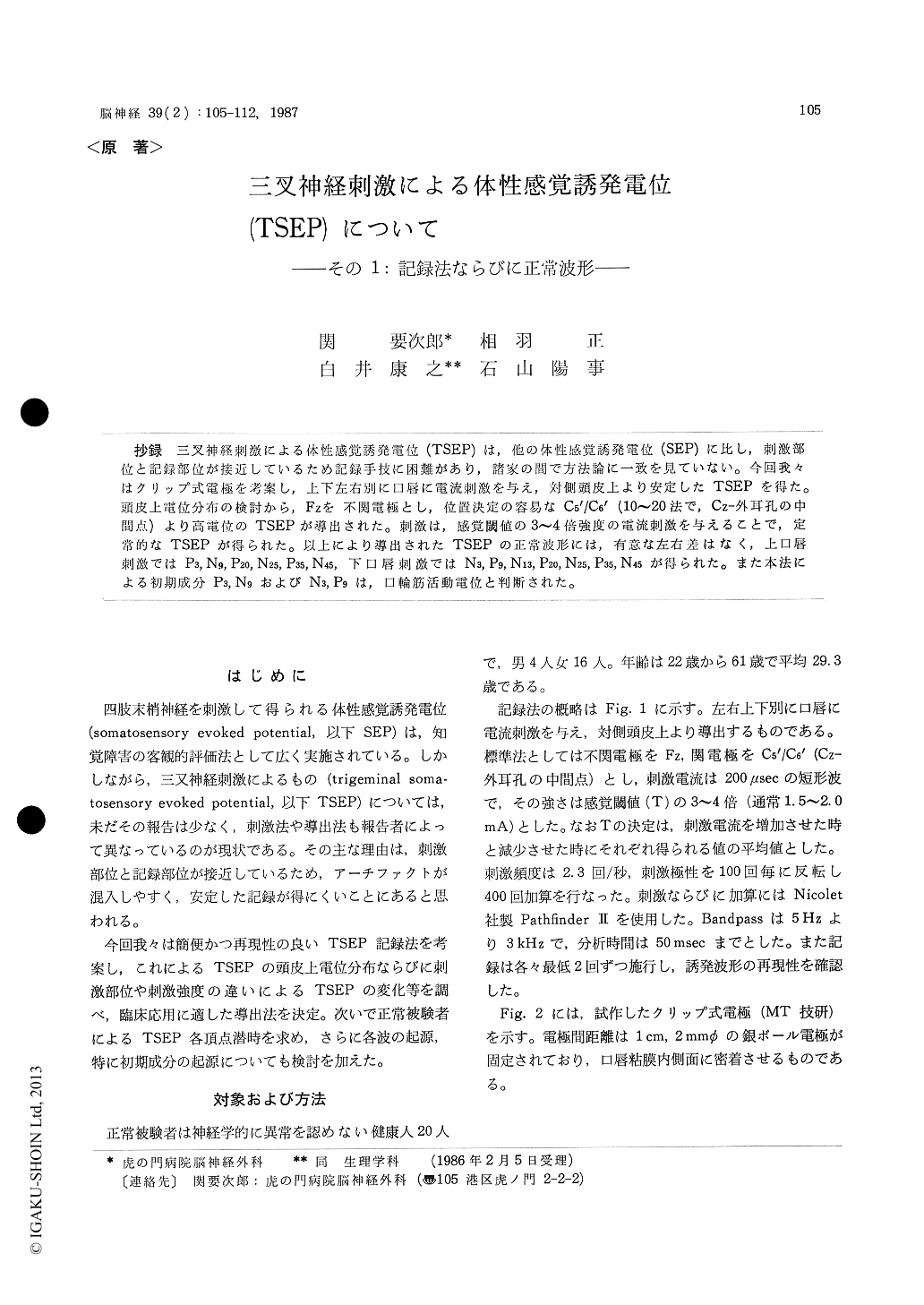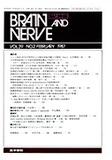Japanese
English
- 有料閲覧
- Abstract 文献概要
- 1ページ目 Look Inside
抄録 三叉神経刺激による体性感覚誘発電位(TSEP)は,他の体性感覚誘発電位(SEP)に比し,刺激部位と記録部位が接近しているため記録手技に困難があり,諸家の間で方法論に一致を見ていない。今回我々はクリップ式電極を考案し,上下左右別に口唇に電流刺激を与え,対側頭皮上より安定したTSEPを得た。頭皮上電位分布の検討から,Fzを不関電極とし,位置決定の容易なC5′/C6′(10〜20法で,Cz—外耳孔の中間点)より高電位のTSEPが導出された。刺激は,感覚閾値の3〜4倍強度の電流刺激を与えることで,定常的なTSEPが得られた。以上により導出されたTSEPの正常波形には,有意な左右差はなく,上口唇刺激ではP3, N9, P20, N25, P35, N45,下口唇刺激ではN3, P9, N13, P20, N25, P35, N45が得られた。また本法による初期成分P3, N9およびN3, P9は,口輪筋活動電位と判断された。
The general wave form and time course of soma-tosensory evoked potentials (SEP) to the stimula-tion of upper and lower extremities has been well known in recent years. However, only a little information has been published so far on SEP to the trigeminal nerve stimulation (TSEP), and at present there is not always common methodology available in clinical practice. These may be due to the technical problems from the close proximity of stimulating and recording electrodes. The pur-pose of this report is to attempt to solve some of the difficulties of the procedure, as well as to show the morphology and time course of TSEP in a group of normal healthy subjects.
Twenty healthy volunteers were investigated. Their age ranged from 22 to 61 years old (mean 29. 3). Clip shaped silver-balled stimulating elect-rodes with 2mm contact surface and interelectrode distance of 10 mm were applied to the inner surface of the lips. They were held in place without any support, thus minimizing muscle activity of the subject. Each half of the upper and lower lip was then stimulated in turn by an electrical rectangular pulse of 3 or 4 times sensory threshold (usually 1.5-2.0 mA) and 0.2 msec duration, at a rate of 2.3 per second. TSEP was recorded contralaterally from C'5 or C'6 (midpoint between Cz and external auditory porus). Fz was used as a reference. Four hundred responses were averaged by a Nicolet Pathfinder II, which also generated stimulation pulses. Stimulus polarity was reversed after each 100 stimuli to eliminate sti-mulus artifact. Analysis time was set to 50 msec. The amplifier bandpass was set between 5 Hz and 3 kHz. All recordings were performed at least twice to confirm the reproducibility.
TSEP of normal subjects were easily obtained by this method with few recording failures. The pattern of TSEP consisted of 6 and 7 discrete peaks by the upper and lower lip stimulation respectively. The mean peak latencies of the waves obtained by stimulating the upper lip were : P3 (3.0±0.3 msec), N9 (8.8±1.1 msec), P20 (19.0 ±1.6 msec), N25 (25.9±2.3 msec), P35 (35.5±2.8 msec) and N45 (43.2±1.9 msec). The mean peak latencies of the lower lip were : N3 (3.7±0.6 msec), P9 (9.6±1.0 msec), N13 (13.2±1.0 msec), P20 (18.1±1.7 msec), N25 (27. ±1.7 msec), P35 (36.1±2.6 msec) and N45 (44.7±2.4 msec). Be-sides those peaks, by the stimulation of the upper lip, N13 was also observed in about 30% of all cases, as a notch of high amplitude N9. Therefore, each peak but first 2 components (P3, N9 upper and N3, P9 lower) was shown to have the same polarity and similar latency between both lip stimulations. These early 2 components were quite different from the later waves. At first, the ampli-tude of these waves depended upon the intensity of stimulus. These biphasic waves were found to have the same peak latencies as EMG of orbicu-laris oris muscle when observed simultaneously from various recording sites. Finally, these early components disappeared in the case of peripheral type facial nerve palsy, but the waves that follow-ed were intact.
Through these investigations, our recording technique of TSEP may be applied to the routine clinical examination of the trigeminal nerve func-tion. Among TSEP obtained by the stimulation of the lips, early components within 10 msec were derived from EMG of orbicularis oris muscle, instead of Gasserian ganglion as reported by some other authors.

Copyright © 1987, Igaku-Shoin Ltd. All rights reserved.


